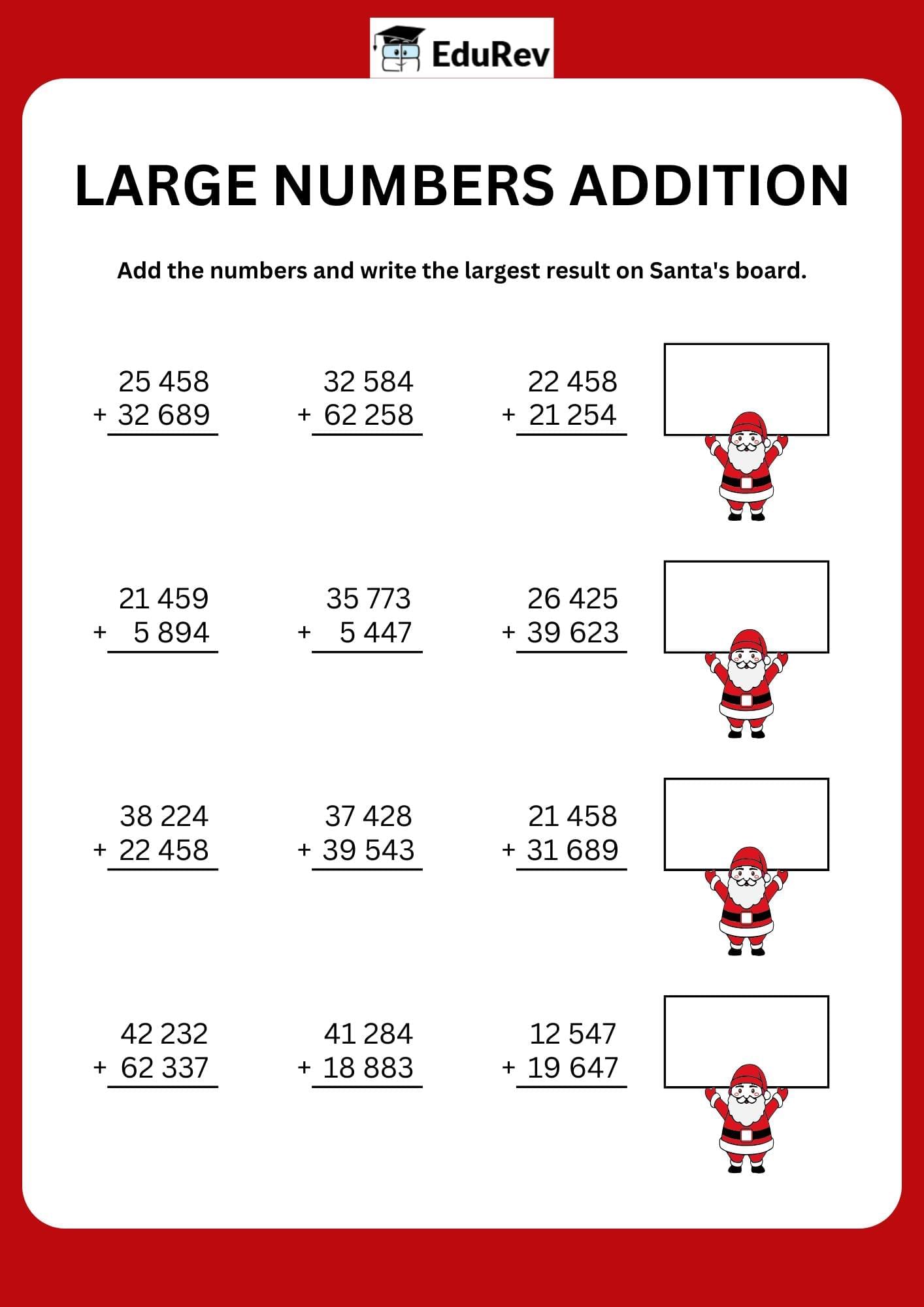Class 5 Exam > Class 5 Notes > Mathematics (Maths Mela) Class 5 - New NCERT > Visual Worsheet: Addition of Large Numbers
Visual Worsheet: Addition of Large Numbers | Mathematics (Maths Mela) Class 5 - New NCERT PDF Download

The document Visual Worsheet: Addition of Large Numbers | Mathematics (Maths Mela) Class 5 - New NCERT is a part of the Class 5 Course Mathematics (Maths Mela) Class 5 - New NCERT.
All you need of Class 5 at this link: Class 5
|
35 videos|322 docs|7 tests
|
FAQs on Visual Worsheet: Addition of Large Numbers - Mathematics (Maths Mela) Class 5 - New NCERT
| 1. What strategies can I use to add large numbers effectively? |  |
Ans. To add large numbers effectively, you can use the following strategies:
1. <b>Column Addition</b>: Write the numbers in columns, aligning them by the place value (units, tens, hundreds, etc.). Start adding from the rightmost column and move to the left, carrying over any extra value as needed.
2. <b>Breakdown Method</b>: Break large numbers into smaller, more manageable parts. For example, to add 456 + 789, you can separate them into (400 + 50 + 6) + (700 + 80 + 9) and then add each part separately before combining the totals.
3. <b>Estimation</b>: Round the numbers to the nearest ten or hundred to estimate the sum. This helps in checking if your final answer is reasonable.
4. <b>Using a Number Line</b>: Visualize the addition on a number line by jumping forward for each number being added. This can help in understanding the concept of addition better.
5. <b>Practice</b>: Regular practice with worksheets and exercises will improve your speed and accuracy in adding large numbers.
| 2. How can I check my addition of large numbers for accuracy? |  |
Ans. To check your addition of large numbers for accuracy, you can use the following methods:
1. <b>Reverse Addition</b>: Add the numbers in reverse order. If both methods give the same result, it’s likely correct.
2. <b>Estimate</b>: Round the numbers before adding them to make a quick estimate of the expected sum. Compare your exact answer with this estimate to see if it’s reasonable.
3. <b>Use of Inverse Operations</b>: Subtract one of the original numbers from your total. If you arrive at the other original number, your addition is likely correct.
4. <b>Peer Review</b>: Have a classmate or teacher review your work. A fresh set of eyes can catch mistakes you might have missed.
5. <b>Calculator Verification</b>: If allowed, you can use a calculator to verify your answer. Just ensure you understand the manual addition process as well.
| 3. What are common mistakes students make when adding large numbers? |  |
Ans. Common mistakes students make when adding large numbers include:
1. <b>Misalignment of Digits</b>: Not aligning numbers correctly by their place values can lead to incorrect sums.
2. <b>Forgetting to Carry Over</b>: When the sum of a column exceeds 9, students may forget to carry the extra value to the next column.
3. <b>Skipping Columns</b>: Some students may skip a column while adding, especially if they get distracted.
4. <b>Inaccurate Addition</b>: Simple addition errors occur, such as adding 8 + 7 and writing 14 instead of carrying the 1 over.
5. <b>Not Checking Work</b>: Failing to double-check their work can lead to missed errors. Implementing checking strategies can help avoid this mistake.
| 4. Why is it important to learn how to add large numbers? |  |
Ans. Learning to add large numbers is important for several reasons:
1. <b>Real-Life Application</b>: Addition is a fundamental skill used in everyday life, such as budgeting, shopping, and cooking.
2. <b>Foundation for Advanced Math</b>: Mastering addition lays the groundwork for more advanced mathematical concepts like subtraction, multiplication, and division.
3. <b>Critical Thinking Development</b>: Working with large numbers enhances problem-solving skills and logical reasoning.
4. <b>Confidence Building</b>: Proficiency in addition boosts confidence in mathematical abilities, encouraging further exploration in the subject.
5. <b>Standardized Testing Preparation</b>: Many standardized tests assess math skills, including addition. Being skilled in this area can lead to better performance.
| 5. What tools can help me practice addition of large numbers? |  |
Ans. Several tools can help you practice the addition of large numbers:
1. <b>Worksheets</b>: Printable worksheets are available online that focus on addition of large numbers, providing various problems to solve.
2. <b>Flashcards</b>: Create flashcards with large numbers on one side and their sums on the other to quiz yourself or others.
3. <b>Educational Apps</b>: There are many apps designed for practicing math skills, including addition. These often include games and interactive challenges.
4. <b>Number Line</b>: Using a number line can help visualize the addition process, making it easier to understand and solve problems.
5. <b>Math Games</b>: Engage in math games that require addition of large numbers, making practice fun and competitive with peers.
Related Searches





















